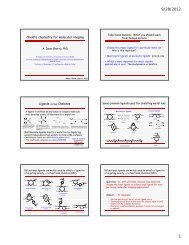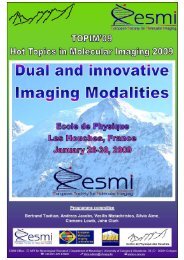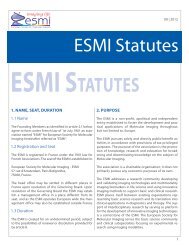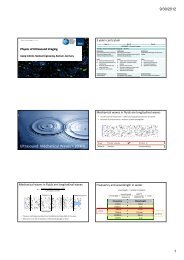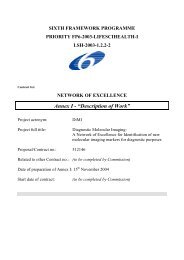5th EuropEan MolEcular IMagIng MEEtIng - ESMI
5th EuropEan MolEcular IMagIng MEEtIng - ESMI
5th EuropEan MolEcular IMagIng MEEtIng - ESMI
Create successful ePaper yourself
Turn your PDF publications into a flip-book with our unique Google optimized e-Paper software.
42 Introduction:<br />
WarSaW, poland May 26 – 29, 2010<br />
Cerenkov radiation imaging of a xenograft murine model of mammary carcinoma<br />
Boschi F. (1) , Calderan L. (1) , D’ambrosio D. (2) , Marengo M. (2) , Fenzi A. (1) , Calandrino R. (3) , Sbarbati A. (1) , Spinelli A. E. (3) .<br />
(1) University of Verona,<br />
(2) S. Orsola – Malpighi University Hospital,<br />
(3) S. Raffaele Scientific Institute.<br />
federico@anatomy.univr.it<br />
2-[18F]fluoro-2-deoxy-D-glucose<br />
( 18 F-FDG) is a well known radiotracer for the in<br />
vivo studies of several diseases. In a previous paper<br />
[1] we showed that the positrons emitted by 18 F-FDG,<br />
travelling into tissues faster than the speed of light<br />
in the same medium, are responsible of Cerenkov<br />
Radiation (CR) emission which is prevalently in the<br />
visible range. The purpose of this work was to show<br />
that Cerenkov radiation escaping from tumour tissues<br />
of small living animals injected with 18 F-FDG<br />
can be detected with optical imaging (OI) techniques<br />
using a commercial optical instrument equipped<br />
with charged coupled detectors.<br />
Methods: In order to demonstrate as a proof of<br />
principle the possibility of imaging tumours using<br />
CR we studied an experimental model of mammary<br />
carcinoma named BB1. BB1 tumours were obtained<br />
by subcutaneous injection of BB1 cells, which are<br />
epithelial cells, from spontaneous mammary carcinomas<br />
of FVB transgenic mice for HER-2/neuT<br />
oncogene. The BB1 carcinomas exhibit histopatological<br />
and vascular features very similar to those<br />
of the parent spontaneous tumours. The BB1 mouse<br />
tumour model was well explained by Galiè and coworkers<br />
[2] and will not be described here.<br />
The images show a comparison between images acquired pre injection (left image) and 1 hour after 18F-<br />
FDG injection for two mice. White arrows indicate the position of the tumour masses.<br />
imaging life<br />
Mice injected with 18 F-FDG or saline solution underwent<br />
dynamic OI acquisition and a comparison<br />
between images were performed. Multispectral analysis<br />
of the radiation was used to estimate the deepness<br />
of the source of Cerenkov light. Small animal<br />
PET images were also acquired in order to compare<br />
the 18 F-FDG bio-distribution measured using OI<br />
and PET scanner.<br />
Results: The first Cerenkov in vivo whole body images<br />
of tumour bearing mouse and the measurements<br />
of the emission spectrum (560-660 nm range) were<br />
presented. Brain, kidneys and tumour were identified<br />
as a source of visible light in the animal body:<br />
the tissue time activity curves reflected the physiological<br />
accumulation of 18 F-FDG in these organs.<br />
The identification is confirmed by the comparison<br />
between CR and 18 F-FDG images.<br />
Conclusions: These results will allow the use of<br />
conventional optical imaging devices for the in<br />
vivo study of the cancer glucose metabolism and<br />
the assessment, for example, of anti-cancer drugs.<br />
Moreover this demonstrates that 18 F-FDG can be<br />
employed as it is as bimodal tracer for PET and OI<br />
techniques.<br />
References:<br />
1. Spinelli A E et al; Phys.<br />
Med. Biol. 55(2):483-<br />
495 (2010)<br />
2. Galiè M et al;<br />
C a r c i n o g e n e s i s .<br />
26:1868-1878 (2005)



